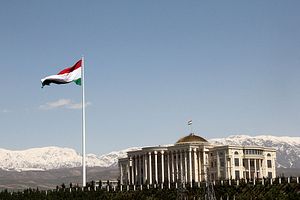The International Monetary Fund concluded an executive visit to Tajikistan in early November, highlighting the macroeconomic and financial weaknesses of the country. The IMF expressed skepticism about the country’s prompt recovery from the current crisis and suggested careful reforms to stabilize the economy. In spite of any hardship, only days later, Tajikistan floated the idea to raise around $850 million in successive bond issues in the coming months.
Last year, the deputy head of Tajikistan’s Central Bank, Jamoliddin Nuraliyev, said the country was chasing a $500 million soft loan from the IMF, which would have given the economy a stepping stone to emerge from the crisis.
“We need financial resources to facilitate credit in the country, so that we can avoid stagnation,” Nuraliyev told local press.
In 2016, Tajikistan’s economic infrastructure showed worrying cracks. The value of remittances from migrant workers had slowed for two consecutive years, while two of the largest banks needed a bail out to heal their portfolios from a large volume of toxic assets. The fall in commodity prices had depressed Tajikistan’s main economic partners and therefore put pressure on its currency, which lost 42 percent of its value against the U.S. dollar over the past three years.
The IMF, however, said it has noted a recovery in the economy for the past year, mostly due to expansionary fiscal policies and booming investments in the construction sector.
“While remittances declined by 45 percent in nominal USD terms in 2015-16, real GDP growth was 6-7 percent,” the IMF November report said.
For the current year, the IMF projects slower growth and a larger external current account deficit, mostly owing to the measures implemented for economic and financial recovery and the costs related to the construction of the Rogun dam and hydroelectric plant, which started last year.
“The external current account deficit is projected to widen to 6.3 percent of GDP, reflecting the liquidity created by the bank recapitalization and imports for a large energy project,” the report said.
Besides ordering the bail outs of Tojiksodirotbank and Agroinvestbank, the Central Bank moved to pull the license of two smaller banks, Tojprombank and Fononbank. Bank customers were compensated up to around $2,000 for their lost deposits, in accordance with the law. This hurt customers and small-scale investors, although a Eurasianet investigation showed that the inconvenience was not evenly spread: “[W]hile authorities look intent on punishing Tojprombank’s smaller debtors, larger delinquent loan-holders, many of them linked to the bank itself, are facing no such pressure.” Despite a $56 million recapitalization in December 2016, Tojprombank was stripped of its license just a few months later. The government seemed to have changed policy, allocating the prospective bailout funds to the construction of Rogun.
The Rogun project also figured in the massive debt sales strategies ordered by the government. In November, Finance Minister Abdusalom Korboniyon said Tajikistan plans to sell bonds for around $850 million over the course of the next three years. The government said it wants to use the cash to finance the dam and hydroelectric plant. Should the market be as hungry for returns as it has been for the past months, such a move would undoubtedly meet high demand from investors.
Analysts were puzzled in September, when Tajikistan’s first international bond issue was significantly oversubscribed. Newspapers said the market was hungry for “junk assets” because of the poor returns in more stable economies. The $500 million 10-year bond was even discounted from the original interest guidance because of the high demand.
International financial institutions have been skeptical about financing the Rogun project. The IMF shied away from a soft loan and the World Bank proposed uninviting conditions for funding. The government, then, decided to bet on the investors’ hunger for returns and put its debt on the market. Given the success of the first subscription in September, the government could continue on the same path. The balance between hunger for returns and trust in solvency, however, is a fickle one for investors. Should they become more conservative in their risk assessments, they could stop betting on a country whose own bond prospectus raised countless red flags.

































